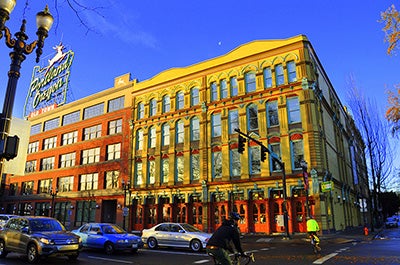The University of Oregon’s Historic Preservation Program is relocating its master’s degree program from the Eugene campus to the UO in Portland beginning fall term 2016.
The university received approval for the move at the September meeting of the state’s Higher Education Coordinating Commission. The UO’s Historic Preservation Program, in its 35th year, is widely recognized as one of the premiere preservation programs in the country. Only two other graduate degree preservation programs are located in the West—at the University of Southern California and the University of Colorado-Denver.
“We are excited to relocate to Portland and work with the next generation of cultural heritage professionals in the research and practice of sustainable historic preservation and other leading issues that define the field of heritage conservation today,” says Professor Kingston Heath, director of the program.

Above: The UO Historic Preservation Program will relocate its graduate degree program to the White Stag Block beginning fall 2016.
The UO program focuses on research in preservation theory and practice, concentrating on the cultural, historical, technological, and environmental factors that shape our world. The UO program trains students to take on careers across the nation. In addition, the diversity of projects available in Oregon from the different regions of the state and in the Pacific Northwest are unique to the field of preservation practice and research.
“The relocation to Portland of the master of science in historic preservation presents an opportunity to take what is already a highly successful and prominent program to the next level as far as its ability to serve the needs of the state and region and to prepare future generations of preservationists to engage in critical and culturally significant work,” says A&AA Interim Dean Brook Muller.
Historic preservation centers on the conservation, interpretation, adaptive re-use, and advocacy of historic sites, structures and objects, and cultural landscapes. “Our program has been recognized for its specialization in documenting, interpreting, and stabilizing vernacular resources throughout the state and region,” Heath notes.
“Students have the opportunity to increase their fluency with historic resources while emphasizing their ability to understand the significance of cultural heritage and resource management within diverse communities,” Heath says of the Oregon program.
The program will benefit from the historic resources in Portland—collections of historic components, historic preservation organizations and public policy advocates, as well as the city’s many historic districts and buildings both restored and under renovation. The UO’s John Yeon Center’s historic properties including The Shire in the Columbia River Gorge, and the Watzek House, a National Historic Landmark, also offer students and professionals opportunities to gain an understanding of the region’s modern-era architecture and landscapes.
“The city of Portland's longstanding commitment to sustainability, adaptive reuse, and preservation of historic buildings, neighborhoods, landscapes, and districts makes this an exciting opportunity for students to live and work in this active preservation community,” Heath adds. “We teach students to think critically not just about the buildings, but what the buildings mean and why they are there.”
In addition to the preservation program’s classroom learning opportunities, UO sponsors two preservation field schools each year—the Croatia Summer Conservation Field School and the Pacific Northwest Preservation Field School (PNWFS). The 2016 PNWFS will be at Mount Rainier National Park.
The master’s degree program will be located in the White Stag Block, which the UO Foundation purchased in November from Venerable Group Inc., in Portland. Since 2008, several UO in Portland programs have occupied space in the White Stag Block, where Venerable Group, Inc. also has its office.
The idea to relocate the UO preservation program to Portland has been in the making for several years. Venerable Group, Inc. founder Art DeMuro, who died in 2012, left a legacy gift to UO to establish funding to increase faculty positions, student scholarships, and move the program to Portland.
Later this month, the UO will begin advertising for a new faculty member to lead the program in Portland and to serve as the school’s first Venerable Chair, made possible with DeMuro’s legacy donation. Application review begins January 4, 2016, with the appointment to begin on September 15, 2016.
The undergraduate minor in historic preservation will continue to be offered in Eugene and the cohort of current graduate students who began the program this fall will be able to complete their degree requirements in Eugene.
Applications for graduate student enrollment in fall 2016 are open now and are due January 15, 2016. To apply, visit the Historic Preservation Program website at hp.uoregon.edu/admissions-process.
The UO has several advanced degree programs in Portland currently offered by architecture, business, law, journalism, and planning, public policy and management. These include the master of architecture, Oregon Leadership in Sustainability certificate, Oregon executive MBA, law, master’s in multimedia journalism, master’s in strategic communications, master’s in sports product management, and master’s in applied information management.
